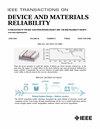Design of 2T DRAM Cell With Surrounding Poly-Si Capacitor for Enhanced Retention and Mitigated Coupling Effect
IF 2.3
3区 工程技术
Q2 ENGINEERING, ELECTRICAL & ELECTRONIC
IEEE Transactions on Device and Materials Reliability
Pub Date : 2025-06-11
DOI:10.1109/TDMR.2025.3578692
引用次数: 0
Abstract
Two-transistors-zero-capacitor (2T0C) DRAM-based processing-in-memory (PIM) system experiences retention degradation and capacitive coupling effects because of its volatile characteristics and capacitorless structure. These challenges result in degraded reliability and significant energy consumption due to frequent refresh operations. In this work, we propose a cell structure with surrounding polycrystalline silicon capacitor (poly-Cap.) to enhance the storage node capacitance of the vertical-transistor on gate (VTG) DRAM cell introduced in our previous work. The poly-Cap. improves the retention characteristics and mitigates the capacitive coupling effects while maintaining its unit cell area. We modeled the VTG DRAM cell with the poly-Cap. and analyzed its device characteristics using TCAD simulations. Additionally, we evaluated the inference accuracy of the 2T DRAM-based PIM system using a customized simulation framework. We confirmed that the poly-Cap. increased the storage node capacitance by 31.9%, improved the retention characteristics by 83.3% and reduced the capacitive coupling effects by 52.4% during the write ‘1’ operation and 27.3% during the read ‘1’ operation.采用多晶硅电容的2T DRAM电池的设计,以增强保持和减轻耦合效应
基于双晶体管-零电容(2T0C) dram的PIM系统由于其易失性和无电容结构导致保留退化和电容耦合效应。由于频繁的刷新操作,这些挑战会导致可靠性下降和大量的能源消耗。在这项工作中,我们提出了一种围绕多晶硅电容器(poly-Cap)的电池结构,以增强我们之前工作中介绍的垂直晶体管门上晶体管(VTG) DRAM电池的存储节点电容。poly-Cap。改善保留特性和减轻电容耦合效应,同时保持其单位电池面积。我们用poly-Cap对VTG DRAM单元进行了建模。并利用TCAD仿真分析了其器件特性。此外,我们使用定制的仿真框架评估了基于2T dram的PIM系统的推理精度。我们确认了poly-Cap。在写“1”操作和读“1”操作期间,电容耦合效应分别降低了52.4%和27.3%,存储节点容量提高了31.9%,保持特性提高了83.3%。
本文章由计算机程序翻译,如有差异,请以英文原文为准。
求助全文
约1分钟内获得全文
求助全文
来源期刊

IEEE Transactions on Device and Materials Reliability
工程技术-工程:电子与电气
CiteScore
4.80
自引率
5.00%
发文量
71
审稿时长
6-12 weeks
期刊介绍:
The scope of the publication includes, but is not limited to Reliability of: Devices, Materials, Processes, Interfaces, Integrated Microsystems (including MEMS & Sensors), Transistors, Technology (CMOS, BiCMOS, etc.), Integrated Circuits (IC, SSI, MSI, LSI, ULSI, ELSI, etc.), Thin Film Transistor Applications. The measurement and understanding of the reliability of such entities at each phase, from the concept stage through research and development and into manufacturing scale-up, provides the overall database on the reliability of the devices, materials, processes, package and other necessities for the successful introduction of a product to market. This reliability database is the foundation for a quality product, which meets customer expectation. A product so developed has high reliability. High quality will be achieved because product weaknesses will have been found (root cause analysis) and designed out of the final product. This process of ever increasing reliability and quality will result in a superior product. In the end, reliability and quality are not one thing; but in a sense everything, which can be or has to be done to guarantee that the product successfully performs in the field under customer conditions. Our goal is to capture these advances. An additional objective is to focus cross fertilized communication in the state of the art of reliability of electronic materials and devices and provide fundamental understanding of basic phenomena that affect reliability. In addition, the publication is a forum for interdisciplinary studies on reliability. An overall goal is to provide leading edge/state of the art information, which is critically relevant to the creation of reliable products.
 求助内容:
求助内容: 应助结果提醒方式:
应助结果提醒方式:


